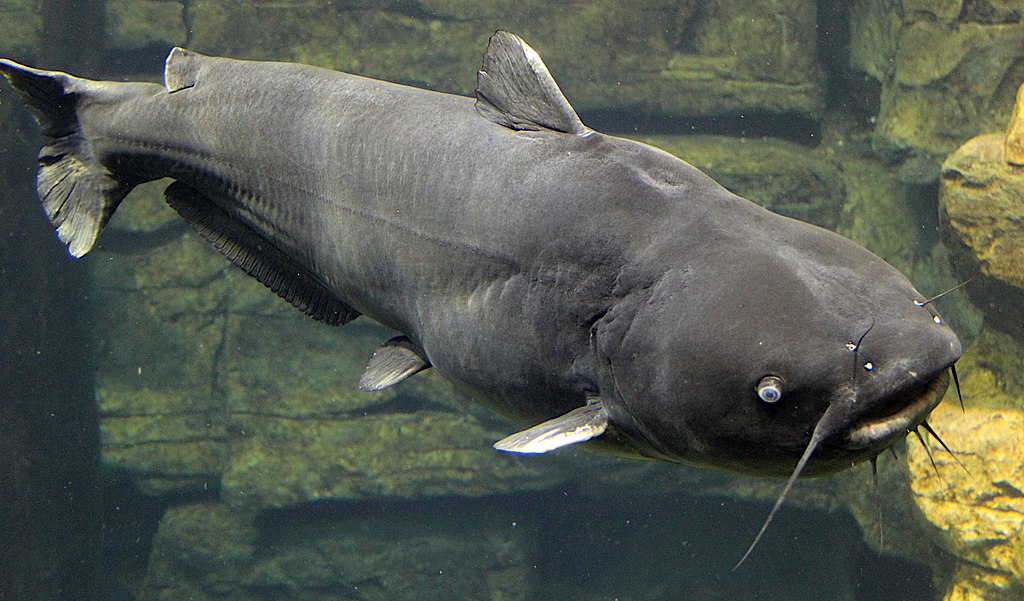
Blue Catfish
Scientific Name: Ictalurus furcatus
Also known as: Channel Cat, Mississippi Catfish, Blue Channel Cat, River Catfish, Mud Cat
General Description
The Blue Catfish is one of the largest and most formidable species of catfish, native to rivers and large reservoirs across North America. Characterized by its bluish-gray or slate-colored body, the Blue Catfish has a slightly forked tail and a long, robust frame. This species can grow to impressive sizes, with individuals regularly reaching lengths of 30 inches to 50 inches and weighing between 30-50 pounds, although some monsters can grow to well over 100 pounds.
Blue Catfish are known for their powerful and aggressive nature, making them a highly sought-after target for anglers looking for a challenge. Their diet consists mainly of smaller fish, invertebrates, and sometimes even smaller mammals. Unlike other species of catfish, Blue Catfish are typically more active during daylight hours, often feeding in the current and deeper waters. They have sharp barbels on their faces to sense vibrations in the water and locate food.
As bottom-dwelling fish, Blue Catfish can be found in both fresh and brackish waters, typically where there are abundant food sources and deep, slow-moving areas. Their strong presence in popular fishing regions has made them a favorite species for those looking to catch large, trophy fish.
Where to Find Them
Blue Catfish are predominantly found in large rivers and reservoirs, particularly in the Mississippi River Basin, and are common in areas such as the Missouri, Ohio, Tennessee, and Red Rivers. The species is native to the United States, where it thrives in slow-moving waters, especially those with significant depths, submerged structures, and moderate to strong current.
While Blue Catfish are known for their preference for deep, swift-moving rivers, they can also be found in many man-made lakes and reservoirs. The reservoirs in the southeastern United States, including those in Georgia and Alabama, have become hotspots for Blue Catfish populations. In these areas, the species can grow to trophy sizes, offering excellent opportunities for anglers targeting large fish.
Blue Catfish are more commonly found in the deep, cooler regions of a waterbody but may migrate into shallower waters during spawning season, typically in the late spring or early summer months. They often gravitate towards submerged ledges, drop-offs, and the deeper sections of rivers, where they can find abundant food sources and refuge from swift currents.
While Blue Catfish can be caught year-round, they are most active during the warmer months, especially in spring and summer, when they are more likely to feed during the day. Their aggressive feeding habits make them a great species for anglers to target during peak fishing times.
Best Baits
Live Bait Options
- Shad (threadfin and gizzard shad)
- Bluegill
- Small channel catfish
- Crayfish
- Freshwater drum
Artificial Bait Options
- Large soft plastics (swimbaits)
- Catfish-specific jigs
- Crankbaits (large, deep-diving varieties)
- Cut bait (scented and fresh)
- Rattlebaits (for added noise in murky water)
Best Fishing Methods
Fishing for Blue Catfish requires specialized techniques and gear, as this species is known for its power and size. Anglers typically use heavy-duty rods and strong fishing lines (usually 30-80 lb test) to handle the force of a big catch. A common method for targeting Blue Catfish is bottom fishing, where baits are weighted and dropped to the bottom of deep water near drop-offs or submerged structures, which Blue Catfish favor.
Another effective technique is drifting, which involves slowly drifting a bait through known feeding areas in the river or reservoir. This method helps to cover a larger area and increases the chances of finding active fish. Anglers use cut bait or live bait to mimic the natural prey of the Blue Catfish. Using scented baits can also increase the chances of attracting these fish, as they have a keen sense of smell.
For those fishing in rivers, casting around bridge pilings or deep holes near currents can be productive. Blue Catfish are often found in deeper channels that are sheltered from the strongest parts of the current, so fishing near these spots can result in a catch.
In the spring and early summer, night fishing is also a popular strategy, as Blue Catfish become more active during the cooler hours. Depending on the time of year, Blue Catfish may move to shallower waters to spawn, and fishing along these shallow edges can be a great way to catch large fish during the spawning season.
Summary
Fishing for Blue Catfish is a rewarding experience, especially for those who enjoy the challenge of landing large, strong fish. With their aggressive nature and powerful fight, Blue Catfish are highly regarded by anglers looking for a trophy catch. These fish are best targeted with heavy-duty gear and a variety of bait options, including live bait like shad and bluegill, or cut bait to attract their attention. When fishing for Blue Catfish, it’s important to focus on deep waters, especially around drop-offs, submerged structures, and river bends where these fish tend to gather.
Blue Catfish are most active in the warmer months, particularly during the spring and summer, and are a great species to target year-round. They are often caught using bottom fishing techniques or drifting with large, scented baits. In addition, anglers can catch Blue Catfish during their spawning season by targeting shallow waters where they move to reproduce. While they can be challenging to catch due to their size and strength, Blue Catfish provide a thrilling fishing experience for anglers of all skill levels.
Whether you are fishing in large rivers or reservoirs, the Blue Catfish is a species that offers ample opportunities to catch trophy fish. For those willing to put in the time and effort to locate and catch these massive fish, the rewards can be well worth it, with the chance to land one of the biggest catfish species in North America.


